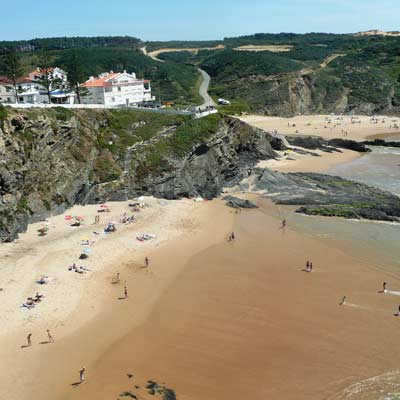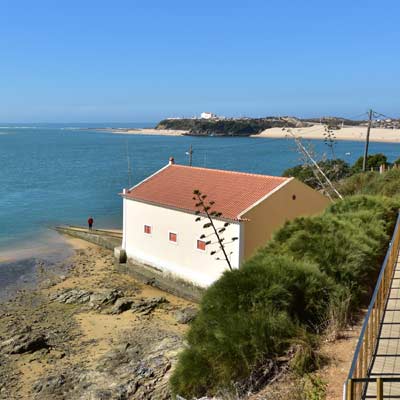MyPortugalHoliday.com
The best independent guide to Portugal
MyPortugalHoliday.com
The best independent guide to Portugal
The Alentejo, Portugal: an independent travel guide for 2025
Stretching across the vast heartland of southern Portugal is the Alentejo, a region of rolling, sun-scorched plains and profound tranquillity. This is a land of immense scale, covering almost a third of the country yet home to just 5% of its population. The result is a landscape of wide-open horizons, ancient cork forests, and a silence that is broken only by the sound of the wind.
The character of the Alentejo is revealed in its contrasts. To the east, along the Spanish border, history is etched into the landscape in the form of formidable fortified towns like Elvas and Marvão. To the west, the region meets the Atlantic, offering a protected coastline of wild surfing beaches, charming fishing villages, and some of Europe’s most dramatic natural scenery.
Life in the Alentejo moves to a different rhythm, one dictated by the seasons and the intense summer heat, which regularly tops 40C (104F). This unhurried pace is central to the region's charm, allowing time to savour its rich culinary traditions, deep-rooted heritage, and the genuine warmth of its people. This is a corner of Portugal that remains deeply connected to its land and its past.
For the traveller seeking to escape the well-trodden tourist trails, the Alentejo is a revelation. It is a destination for unhurried road trips along empty highways, for discovering historic towns without the crowds, and for finding a stretch of wild coastline all to yourself. This guide will provide everything you need to explore this magnificent region.
Highlights of the Alentejo, Portugal
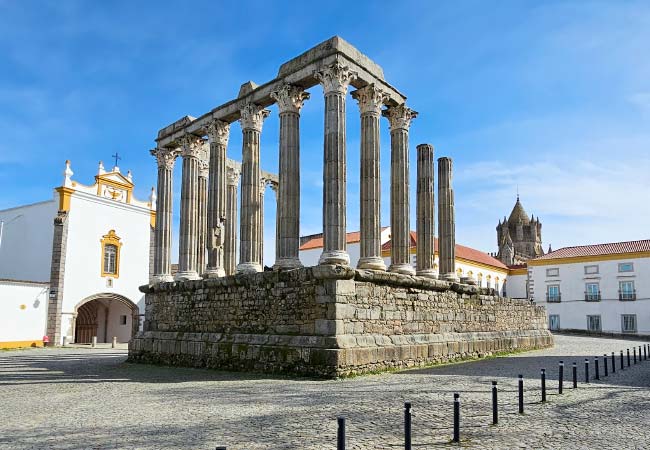
Evora - The stunning capital of the Alentejo, this UNESCO World Heritage city is a journey through time, from its perfectly preserved Roman temple to the medieval palaces of its golden age. (Guide to Evora here)
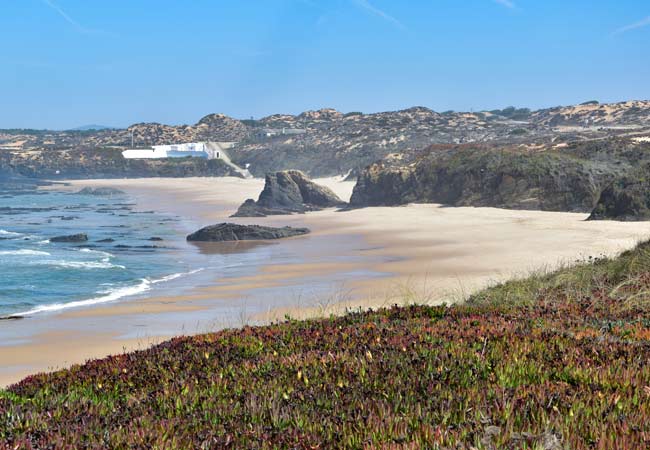
Vila Nova de Milfontes - Positioned at the mouth of the Mira River, this is the Alentejo coast’s most charming resort, beloved for its pristine beaches and setting within the protected Vicentine Coast Natural Park. (Guide to Vila Nova de Milfontes)
Monsaraz – A tiny, walled medieval village of whitewashed houses and cobbled lanes, Monsaraz sits perched atop a hill, offering breathtaking views over the vast Alqueva Lake.

Mertola – The historic last river port on the Guadiana, Mértola is a peaceful town crowned by a Moorish castle, with a fascinating past evident in its unique church that was once a mosque.
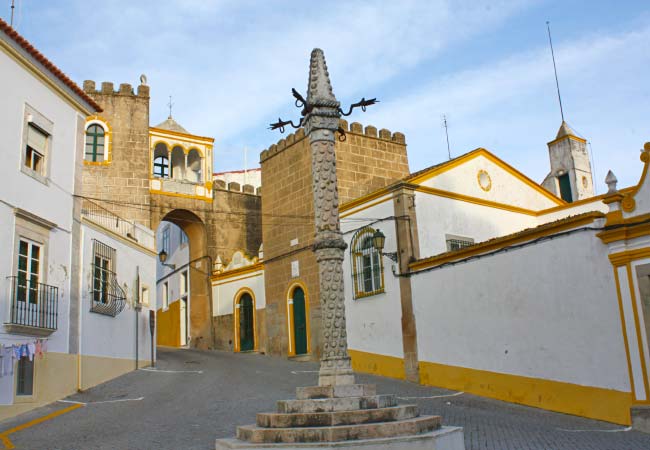
Elvas – A formidable UNESCO-listed garrison town on the Spanish border, Elvas is defined by its revolutionary star-shaped fortifications, the largest and best-preserved of their kind in the world. (Elvas guide)
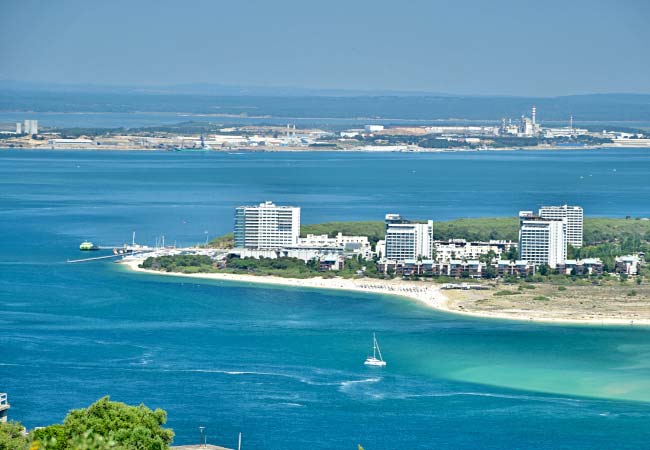
Península de Troia – A spectacular sandbar peninsula of pristine beaches and turquoise waters, Tróia is a sophisticated resort destination that is also secluded hideaway of Europe’s rich. (Troia guide)
The Alentejo for tourists
Tourists visiting the Alentejo typically explore one of three areas: the medieval towns on the route to Spain, the villages dotting the Atlantic coastline, or the picturesque towns in the Serra de São Mamede mountains.
Evora and the route to Spain
The historic trading route between Spain and Lisbon passes through a natural depression through the granite hills along the border, and this route has always been heavily fortified. At the heart of the region is the ancient cathedral city of Evora, while at the border is the unique star-shaped defences of Elvas, along with numerous forts such as at Evoramonte.
This region contains large deposits of marble and the towns of Borba, Estremoz and Vila Viçosa are known as the “marble towns” as they used it extensively as a building material. To the south, and also constructed to guard the border, is the picturesque walled town of Monsaraz.
Related articles: Evora - Elvas
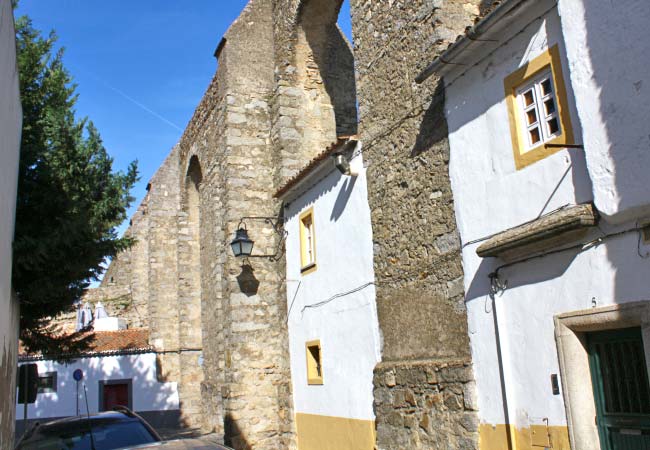
In Evora, houses were constructed under the arches of the aqueduct
Alentejo coastline
The Alentejo coastline is wild and dramatic and contains some of Portugal’s finest beaches. There are vast expanses of sand, towering cliffs, unspoilt countryside and charming villages.
In the summer, these coastal villages are lively with Portuguese tourists, but outside of this short summer season, this stunning coastline is near deserted. The three best villages for a holiday are Vila Nova de Milfontes, Porto Covo and Zambujeira do Mar, and much more characterful and charming than anything found in the touristy Algarve.
At the far northern tip of the Alentejo coastline are the paradise beaches of the Península de Troia and Comporta. This region is a favourite with Europe’s rich, who have constructed secluded villas hidden within the pine forests.
Insight: The city of Sines should be a great tourist destination, as a major historic city close to wonderful beaches. Sadly, the city has a spawling port and oil refinery, and is best avoided.
Related articles: Vila Nova de Milfontes - Península de Troia
Serra de São Mamede
To the northeast of the Alentejo is the Serra de São Mamede mountain range, and the delightful walled towns of Marvão and Castelo de Vide. A tour of this region also usually includes Castelo Branco and Monsanto, though technically they are not in the Alentejo region.
Insight: While the Serra de São Mamede mountains are beautiful, those seeking spectacular scenery, hiking trails and outdoor activities might prefer the Serra da Estrela.
Related articles: Monsanto - Serra da Estrela
Off the beaten track in the Baixo Alentejo
The final way to explore the Alentejo is to go completely off the beaten track, and see the interior of the Baixo Alentejo. This sparse area includes the pretty riverside town of Mertola, the reservoir lake at Alqueva and the historic agricultural city of Beja.
Advice: As romantic as it sounds “going off the beaten track”, the southern Baixo Alentejo region is very empty. The poor soils and intense summer heat make farming difficult, and the majority of the region is made up from parched scrublands, olive trees and tiny nondescript farming villages.
The interactive map below shows the Alentejo region along with the three suggested tour routes.
Key 1) Evora 2) Evoramonte 3) Estremoz 4) Vila Viçosa 5) Borba 6) Elvas 7) Monsaraz 8) Península de Troia 9) Comporta 10) Sines 11) Porto Covo 12) Vila Nova de Milfontes 13) Praia de Almograve 14) Zambujeira do Mar 15) Aljezur 16) Portalegre 17) Marvão 18) Castelo de Vide 19) Castelo Branco 20) Monsanto 21) Beja 22) Mértola 23) Alqueva
When to visit the Alentejo?
The Alentejo is the hottest and driest region of Portugal.
Early spring is the ideal time to explore the region, offering pleasant weather, blooming wildflowers, and fewer tourists. During the summer the Alentejo is baked by the intense sun and temperatures reach in excess of 40°C, this makes most sightseeing unbearable. Winters are cooler, but there is always the chance of rain.
The best towns of the Alentejo
Monsaraz
Perched on a hilltop in eastern Alentejo, Monsaraz overlooks the vast Alqueva Lake and Guadiana Valley. This medieval village, with its weather-beaten castle and whitewashed cottages, offers a glimpse into Portugal's rich history. Wander its narrow streets to discover 16th-century churches, a rare 14th-century fresco, and local artisan shops. Beyond the village walls, prehistoric megaliths dot the landscape, while the dark skies above provide excellent stargazing opportunities.
Mértola
This picturesque town sits at the highest navigable point of the Guadiana River. Its strategic location shaped its rich past, evident in the Moorish-influenced architecture. The medieval castle offers panoramic views of the surrounding landscape. Beyond the town walls, the Parque Natural do Vale do Guadiana is home to diverse flora and fauna, including the elusive black stork.
Marvão
Situated on the highest crest of the Serra de São Mamede, at 865 meters above sea level, Marvão is the gem of eastern Portugal. This well-preserved medieval settlement boasts 13th-century walls, a formidable castle, and picturesque stone-paved streets lined with traditional white-washed houses. Marvão's tranquil atmosphere, rich history, and proximity to the Serra de São Mamede make it an enchanting retreat for those seeking an authentic Portuguese experience.
Elvas
The heavily fortified border town of Elvas is a testament to Portugal's military prowess. Its UNESCO-listed fortifications include star-shaped walls and outlying forts that once safeguarded the nation's independence. The town's historic center, with its Gothic-Moorish cathedral and winding streets, contrasts with the monumental 6km-long Amoreira Aqueduct. Elvas provides an authentic taste of Portuguese heritage away from the typical tourist trail.
Évora
Set in the heart of Alentejo, Évora offers visitors a journey through millennia of history. The city's compact historic center, a UNESCO World Heritage site, is home to the ancient Temple of Diana and the haunting Capela dos Ossos. The university, founded in 1559, lends a youthful energy to the medieval streets. Évora serves as an ideal base for exploring the region's cork forests, vineyards, and prehistoric monuments.
Vila Nova de Milfontes
At the mouth of the Mira River in Alentejo, Vila Nova de Milfontes boasts diverse beaches from the calm Praia da Franquia to the surf-friendly Praia do Malhão. This Alentejo coastal town retains its traditional charm while providing water activities from surfing to kayaking. Explore the 16th-century Forte de São Clemente, hike the Rota Vicentina trails, or simply unwind on pristine beaches like Praia da Franquia. Vila Nova de Milfontes presents a relaxed alternative to the bustling Algarve.
How to travel around the Alentejo?
To get the most out of the Alentejo region, a car is required. There is generally good public transport between the major towns and to Lisbon, but there are very limited bus services in the surrounding countryside.
The main intercity bus company of Portugal is Rede Expressos, and their website can be seen here: www.
Food of the Alentejo
The Alentejo region has always been a major pork-producing region, with the pigs able to graze freely on the acorns that fell from the cork trees. A regional highlight is the "Porco Preto" - prime cuts from the traditional free-roaming Iberian Black Pig.
A unique dish is Migas à Alentejana, a meal based on wheat bread, which is pan-fried in a garlic olive oil sauce and served with chunks of pork. Also worth trying is Carne de Porco à Alentejana (Pork meat from the Alentejo) a delicious mix of pork, clams and diced fried potatoes.
The Alentejo is a major wine producer, which typically produces red wines. If you wish to visit more of the vineyards of the region, see the excellent Vinhos do Alentejo website: www.
The people of the Alentejo region
The people of the Alentejo region are conservative, hardworking and very different from the more populous regions of Portugal. These cultural differences are reflected in the varied regional dishes, which tend to be hearty and filling.
Discover more of central Portugal with our guides
If you've found our content valuable, we'd welcome your support.
The digital publishing landscape has evolved significantly. As a small independent publisher, we face growing challenges. Search engines increasingly favour paid content over organic results, while AI-generated content often reproduces original work without attribution.
To support our work, please consider bookmarking this page (press Ctrl + D) for quick access. If you find an article helpful, we'd be grateful if you'd share it with friends on social media.
For specific questions, please see our Reddit community at r/LisbonPortugalTravel.
Should you notice any outdated or incorrect information, please contact us at [email protected]
Thank you for helping us continue to provide valuable content in an increasingly challenging digital environment.
